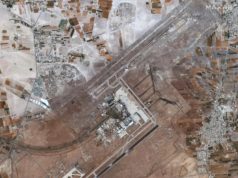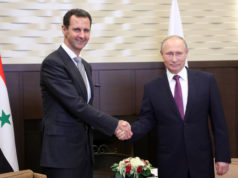Matthew RJ Brodsky addressed the Center for Security Policy’s National Security Group lunch at the Capitol on April 9, 2010. Below is a copy of the prepared remarks.
Syria and the Obama Administration
Forty years ago, in assessing the foreign policy direction of the regime of Hafiz al-Asad in Damascus, the CIA concluded that “[t]he question in regard to Syria’s future… is not whether it will be moderate or radical, but what will be the kind and intensity of its radicalism.” Four decades later, the Obama administration has been struggling with the same question as it has worked to craft a new policy toward Syria.
These days, most politicians seem to favor engagement, ever looking inward to find the American solution to Syria’s behavioral problems. The thinking is that if the United States would only offer this carrot or that incentive, Syria would reorient itself away from Iran and terrorists, dump its designs to establish a Greater Syria, stop subverting its neighbors, and become a constructive player in the Middle East—perhaps even a U.S. ally. Some have even posited the idea that the problem with Syria actually lies with us, and our failure to explain to Damascus how changing its behavior would actually benefit the regime there.
Before taking office, the working assumption that emerged among many in the Obama administration was that the problem was not as much about the hostile and belligerent ideologies of states and actors such as Syria, Iran, Hezbollah, and Hamas, but rather the style with which Bush conducted statecraft. This inaccurate yet widely held narrative of Bush’s abrasive diplomacy led many to conclude that the confrontational posture and aggressive diplomacy had been tried and failed. Instead, through diplomatic engagement and by offering rewards and incentives, rogue regimes such as Syria and Iran would alter their behavior. This persistent error in judgment continues to affect how the U.S. engages with the Middle East.
First let’s be clear on what our problems are with the Asad regime: Syria’s importance in the Middle East rests not on its ability to play a constructive role in the region but rather from its ability to make mischief. Syria is a charter member of the State Department’s State Sponsors of Terrorism list, making the list with its first publication in 1979, and it is a title that is well-warranted. Indeed, since the 1960s, Damascus has used terrorism to advance its goals internally and in the region by employing such methods as the assassination of political rivals and attacks on Israeli, Jewish, Lebanese, and Western target.
· Middle East Peace Process: It serves as host and supporter to the most radical opponents of peace from Hamas, to Hezbollah, to Islamic Jihad. The regime has indicated that it could use its influence with these groups but they provide cover – not influence.
· Lebanon: Main backer of Hezbollah – an organization responsible for more American deaths prior to 9/11/01. They provide material support and training and equipment. They refuse to demarcate their border with Lebanon.
· Iraq: Bashar al-Asad did not want the U.S. to invade Iraq, and once it did, he did not want the U.S. to be successful, retain a military presence there, or have political influence to the east of his border. As a matter of policy, the Syrian government financed, trained, armed, encouraged, and transported foreign jihadists to fight against both Coalition forces in Iraq and the fledgling army of the new Iraqi government. Once the war began in 2003, state-chartered buses transported insurgents with considerable fanfare and publicity. So brazen was Syria’s support for jihad against the United States that the regime allowed volunteers seeking to fight the U.S.-led coalition in Iraq to gather in front of the Iraqi embassy, located across from the U.S. embassy, while the Syrian mufti – the most senior state-appointed cleric – formally endorsed holy war against the coalition forces. This was nothing short of a declaration of war on the United States. This support continues to this day. Indeed, on September 11, 2009, America’s top commander in Iraq, General Ray Ordierno said, “[d]uring the past years, Syria was lending indirect support to some of the fighters, on top of financial support. Syria has not changed this type of interference.” He also said: “Syria continues to allow the facilitation of foreign fighters through Syria that both come into Iraq as well as, I believe, into Afghanistan.”
Above all of this are 2 other important issues. The UN investigation into the assassination of former Lebanese Prime Minister Rafiq Hariri – in which most fingers point to a combination of involvement between the Asad regime and Hezbollah. It was this event in February 2005 that had the Bush administration recall our ambassador. The other is the IAEA investigation into Syria’s nuclear reactor destroyed by Israel in September 2007. Syria is refusing to cooperate with both investigations.
Obama’s approach
Obama’s engagement strategy with Syria is based on two fundamental and misguided assumptions. The first is that it is possible to effectively pry Damascus apart from its alliance with Tehran, which will make engaging with Iran and solving the nuclear issue easier for the United States. But the durable Syrian-Iranian alliance is not a reactive marriage of convenience. They seek to overturn the regional balance of power and undermine Israel, Egypt, and Saudi Arabia, as well as the United States. Furthermore, Iran’s pursuit of nuclear weapons does not depend on Syria.
There is no concession that the U.S. can receive from Syria that would not be exponentially greater if it were received from Iran. A weakened Iran, and therefore a weakened Syrian-Iranian alliance would transform Syria into a fourth-rate power, void of natural resources, and with little influence in the Middle East. It would limit Syria’s ability to sow the seeds of destruction around the region. The reverse, however, is not true. Therefore, the Obama administration is wasting valuable time and resources rewarding Damascus with engagement while the key to unlocking progress in the region lies in Tehran. This points to Washington’s inability to understand that America’s problems with Iran will not be solved or improved by a change in Syrian behavior.
The second misguided assumption is that Syria is ready to sign a peace agreement with Israel that will be acceptable in Jerusalem and in Washington. But Asad’s concept of peace with Israel was revealed last year in an interview with the Emirati newspaper, al-Khaleej: “A peace agreement,” Asad said, “is a piece of paper you sign. This does not mean trade and normal relations, or borders, or otherwise.” This should be a troubling sign for Israel. After all, a peace agreement with Syria today is no longer about land for peace but land for Syria’s strategic realignment. This would mean turning away from Iran and ceasing the support for terrorist groups devoted to Israel’s destruction. Therefore, in exchange for all of the Golan Heights and Syrian access to the Sea of Galilee, in a hypothetical peace, Syria would still keep the Hamas and Islamic Jihad offices open for business in Damascus, while arming Hezbollah in Lebanon. This form of peace would not benefit the United States or Israel.
Looking Forward
One can only hope that the future doesn’t resemble February 2010. During that month the Asad regime rejected an IAEA request for a meeting; began importing sensitive nuclear-related military equipment from North Korea; exported Syrian-made Fateh-110 missiles to Hezbollah; began training the terrorist group in the use of SA-2 and SA-6 surface-to-surface missiles; mocked Hillary Clinton and the Obama administration with Ahmadinejad over dinner in Damascus; met with Hezbollah’s leader during lunch; vowed to strengthen its relationship with Tehran; pledged to continue support for the resistance; and threatened missile attacks against Israeli cities. It is an impressive litany to which the Obama administration responded by naming a new ambassador to Syria and lifting the State Department’s travel warning for the county.
The Obama administration’s current policy towards the Asad regime is to hope Syria will change in exchange for gestures from Washington. Instead, the White House should learn from the experiences of successive U.S. and Israeli governments. Syria’s importance in the Middle East stems not from its ability to play a constructive role in region, but rather from its ability to cause mischief and wreak havoc upon its neighbors.
Furthermore, the argument made in Washington that aggressive diplomacy with Syria was tried and failed and now engagement and incentives must be the order of the day, is false. Neither a carrot nor stick approach has been fully explored. And one thing is certain: Syria’s rogue behavior is not the result of Washington’s diplomatic communications skills; it is the result of strategic calculations and decisions made by Damascus.
The Obama administration should be ratcheting up the pressure on the Asad regime rather than easing its pain. Syria should be presented with difficult choices that will unequivocally and irreversibly demonstrate that it has changed its worldview and behavior, before being presented with rewards for future promises.





